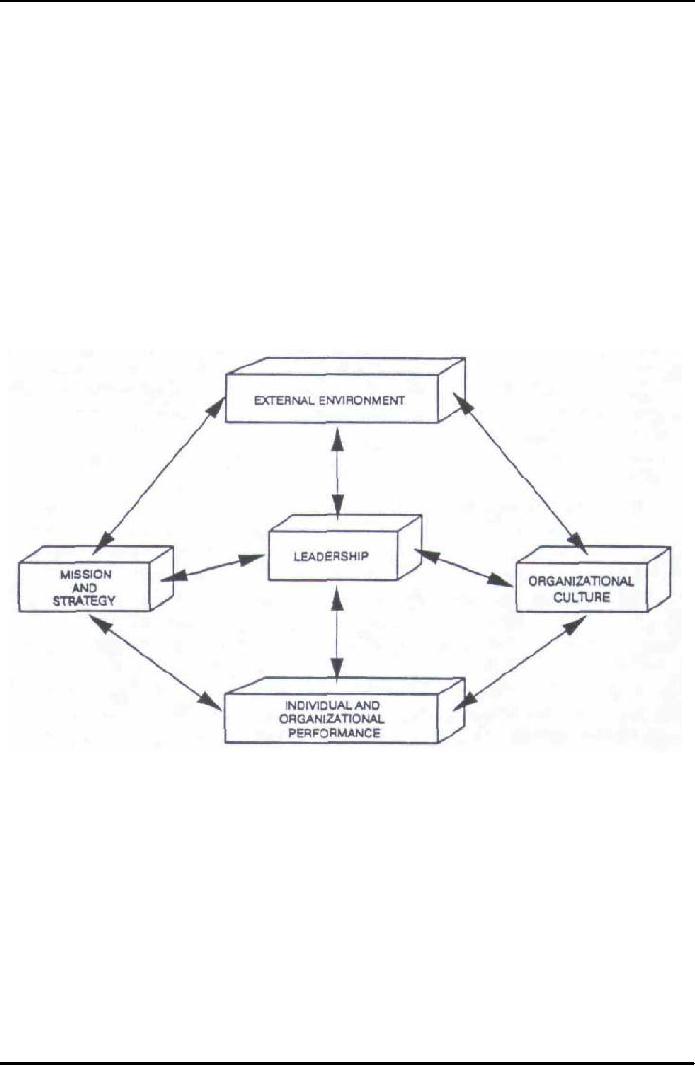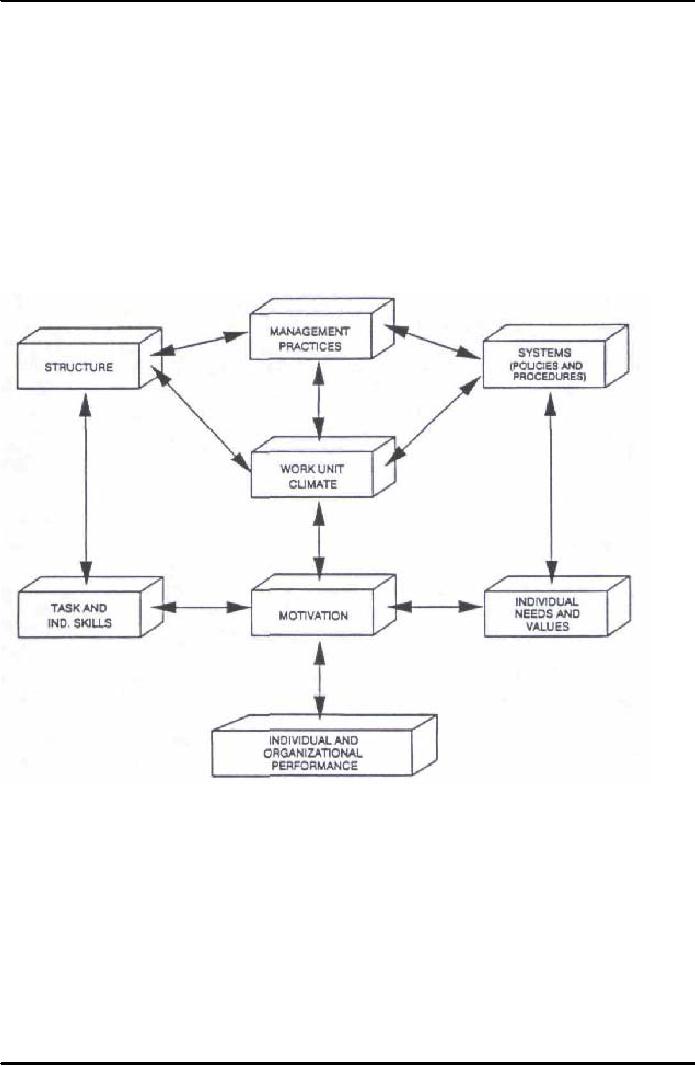 |

Change
Management MGMT625
VU
Lesson
# 43
CHANGE
IMPLEMENTATION: OD MODELS
Earlier we
discussed three implementation
approaches in our previous
which were:
1.
Logical Incrementalism
2.
Transformational or Revolutionary
Change
3.
Punctuated Equilibrium
Model
And
now in this lesson at first we will be
discussing Organization Development
(OD) model
and
subsequently we will study the
Burke-Litwin Model of Organizational
Change.
Organization
Development Model
In
studying the change management, one
might think of differentiating
the two disciplines:
OD
and
Change Management (CM). Apparently it
seems both are relatively
parallel to each
other.
It
means that most of the
things which we have covered
in change management course are also
be
the subject matter of
organizational development. So,
then the question is: Is OD
and CM
are
the same disciplines or
there exist any kind of
difference between
them?
To
answering this question, we
need to have an in-depth
knowledge about the
evolution of
both
OD and CM disciplines. However in broader
terms, we can say that OD deals
with the
internal
dynamics of the organization
which sometimes identified as
`Orgonomics.' From
the
post
World War - II era until
early 1980s, the OD
discipline proved itself to be
very successful
amongst
organizations' strategists, consultants and
management practitioners. But it
has lost its
vigor,
enormity and strengths from
early 80s because of
emerging changes and
challenges
external
to organizations such as oil
crisis and regional wars. In
the wake of this
Change
Management
has emerged as more
comprehensive and profound discipline
for dealing with
intricacies
of both internal and external
environment.
Defining
Organization Development
OD
is a planned and sustained effort to
apply behavioral science for
system improvement,
using
reflexive and self analytic
methods.
(Schmuck
and Miles, 1971)
OD
is a process of planned change, change of an
organization culture from one
which
avoids
an examination of social processes
especially decision making,
planning, and
communication
- to one which institutionalizes and
legitimizes this
examination.
(Burke
and Herrnstein, 1972)
In
both the definitions, we
have seen that the change
restoration in an organization is
a
deliberate
or planned process which
requires appropriate scientific
techniques and careful
interplay
among different variables
such as strategy, structure,
technology, and leadership
for
achieving
sustainability, productivity, and
innovation.
Historical
Context of Organization
Development
Here
we need to discuss the
historical context of change management
thought itself which
can
help
us in rediscovering and understanding the
relevance of ideas and practices of the
given
discipline.
This may give us insights,
ideas, and the conceptual
underpinnings of management
132

Change
Management MGMT625
VU
theory
and practice as well. In principles of
management course we have already
studied
different
theories and approaches to management
which Koontz termed as, a
`management
theory
jungle'. This give us an
idea to review the
literature for change management as
well,
which
could be worth studying for
who are further interested
in specializations in management
disciplines.
The review reveals
significantly that change management
theories ad practices are
also
bound and conditioned by time and
space. For instance in
today's context change
management
experts are now stressing on
the revised version of OD
which is based on
empowerment
paradigm, delegation, decentralization
and participative decision making.
The
authority,
line and communication system
structure should be multi-dimensional,
multi-
directional
and hybrid one which could
have the ability to achieve
the modern standards
such
as
consultancy, information sharing,
knowledge worker and knowledge management
paradigm
that
have been revealed in modern
researches. Because, it is now considered
that effective
management
has to start with subordinates or at
operational level. However,
the same OD
model,
dates back to theorizing in early
twentieth century, had been
based on the assumptions
that
were exactly opposite to what we
have today. Even Frederick
W. Taylor, who is
widely
acknowledged
as `the father of scientific
management', has been
reviewed as the one
who
made
the organization a rigid or sometimes a
hegemonic body. In brief,
Taylor's answer to
the
problem
of productivity - the split in
thinking between pay and
profits - was a derivative of
from
the application of scientific
methods, instead of custom and rule of
thumb, carried only
managerial
solutions at that time, and
which is increasingly looked at
critically now a
days.
Despite
the inexactness and early hegemonic
theorizing, the OD model had
achieved the
successful
status in all over the world
in post world war II era
till the end of 1970s. But
what
happened
after that? Organization strategists and
theorists had observed that OD has
certain
limitations
and hence unable to address certain
aspects of the organizations.
They also
observed
that it worked effectively
for organizations in growth
phase of business cycles
and
badly
stagnated at late maturity
stage of business cycles. At
this point, OD as a
discipline
evolved
to a new discipline `Change
Management' which has the
ability to incorporate
both
internal
and external environments effectively.
And this evolution had changed
the earlier
established
assumptions to the new ones
such as empowerment, delegation,
decentralization
and
participative decision
making.
Second,
this evolution also caused a
revolutionary shift from
underlying scientific approach to
cultural
approach in management. As Taylor
believed that there is
always one best way
available
to deal any particular thing and
the operationalists also generally
assumed that the
fundamentals
of management are universal in nature and
application. Similarly, the
scientific
approach
is also the working for
universalization of any phenomenon
across time and
space.
On
the other hand, acceptance
of such managerial principles
like decentralization,
delegation
and
participative will be nullifying the
assumption that management is something
thing which
is
universal. The concepts such as
multiple-rationality, equi-finality and
multiculturalism are
also
there to show the relevance
and validity of the claim
that management principles
are
culturally
based. Therefore there could
be multiple and many ways
for doing something.
This
lead
to the formation of management
school which believes that
there are distinct cultural
ways
of
management in different organizations
across various cultural
entities.
Attributes
of Organization Development
model
From
an OD framework, we have number of
models highlighting multiple
levels of
complexities
and depths, including Kurt Lewin
model, and in general we have
found some
common
attributes that exist almost
in every recognized model. These
are:
1.
assumptions of planned change
133

Change
Management MGMT625
VU
2.
a frame work to diagnose the
problems
3.
a cause and effect linkage
for visualizing the domain
of problems
4.
supremacy of the process for
rectification or feedback loop
5.
predictability or causality
Burke
Litwin Model of Organizational
Change
Burke
Litwin model is based on
organizational performance and change by
exploring the
interplay
between organizational functioning and
organizational change. Change is depicted in
terms
of both process and content,
with particular emphasis on
transformational as compared
with
transactional factors. Transformational
change occurs as a response to the
external
environment
and directly affects organizational
mission and strategy, the
organization's
leadership,
aid culture, In turn; the
transactional factors are
affected by structure, systems,
management
practices, and climate. These transformational and
transactional factors
together
affect
motivation, which, in turn,
affects performance. It can be applied to
both individual and
organisational
performance. The model is
given as under:
Figure
1
A
Model of Organizational Performance and
Change;
The
Transformational Factors
Transformational
and Transactional Dynamics
The
model shows how to create
first-order change and second-order change (this
author calls
as
transactional change and transformational
change). The concept of
transformational change
in
organizations is suggested in the
writings of such people as Bass
(1985), Burke (1986),
Burns
(1978), McClelland (1975), and
Tichy and Devanna (1986).
The above figure 1
contains
a
display of the transformational
variables in the upper
half of the model. By
transformational
we mean areas in which alteration is
likely caused by interaction
with
134

Change
Management MGMT625
VU
environmental
forces (from both within and
without) and will require entirely
new behavior
sets
from organizational members.
It
is true, of course, that members can
influence their organization's
environment so that
certain
influence
of the changes are minimized
(e.g., lobbying activities,
forming or being involved
in
trade
associations and coalitions). The feedback
loop, designed by authors, in
the model is
meant
to reflect this kind of
influence. Our point here is
that for the most
part organization
change
is initiated by forces from
the organization's external
environment, for
examples
changes
in the competitive environment,
government regulations and
technological
breakthroughs,
and is quite decisive in influencing
organizational change.
Figure
2 contains the transactional
variables - the lower half
of the model. By transactional
the
authors
mean that the primary way of
alteration is via relatively
short-term reciprocity
among
people
and groups. In other words, "You do
this for me and I'll do that
for you."
Figure
2
A
Model of Organizational Performance and
Change;
The
Transactional Factors
Organizational
Climate and Organizational CultureThis
model also distinguishes
between
organisational
climate and organisational culture.
Organisational climate is defined as
people's
perception
and attitude that strongly
affected by organizational conditions
(e.g., systems,
structure,
manager behaviour, etc). The
resultant psychological state
could be good or bad,
friendly
or unfriendly, hard-working or easy
going. These perceptions are relatively
easier to
change
because they are built on
employees reaction to current
organisational and managerial
practices
135

Change
Management MGMT625
VU
The
concept of culture, drawn
from anthropology by authors, is
meant to describe the
relatively
enduring
set of values and norms that
underlie a social system. These
underlying values and
norms
may not be entirely
available to one's consciousness. They
are thought to describe
a
"meaning
system" that allows members of
that social system to
attribute meanings and
values
to
the variety of external and
internal events that are
experienced. Changing culture is
much
more
difficult than changing
climate.
When
we describe culture as the
underlying values and meaning systems of
an organization,
we
describe those forces that
create the dimensions of
climate, those underlying ideas
and
images
around which specific
attitudes and behaviors cluster.
Thus, when we attempt to
alter
the
organizational culture, we change the
climate framework (i.e. the
gauge by which
organizational
members perceive their work
climate). While, the
day-to-day climate will be a
result
of transactions around such
issues as:
1.
Sense
of direction: effect of mission's
clarity or lack
thereof.
2.
Role
and responsibility: effect of structure
reinforced by manager practice.
3.
Standards
and commitment: effect of manager
practice, reinforced by
culture.
4.
Fairness
of rewards: effect of systems, reinforced
by manager practice.
5.
Focus
on customer versus internal
pressures, standards of excellence:
effect of culture,
reinforced
by other variables.
The
Model
The
total of 12 boxes represents the
choice of organizational variables by
the authors consider
to
be the most important ones.
In addition, they also have
attempted to account for
key
variables
at a total system level,
with such variables as
mission, strategy, and culture, at
a
group
or local work unit level
(e.g., climate) and at an individual
level (e.g.,
motivation,
individual
needs and values, and job-person
match).
A
change in one (or more) "box
(es)" will eventually have an
impact on the others.
Moreover,
if
we could diagram the model
such that the arrows
would be more circular - the
hologram idea
-
reality could be represented
more accurately. Yet this is a causal
model. For example,
though
culture
and systems affect one another, we
believe culture has a
stronger influence on systems
than
vice versa. Kerr and Slocum
{1987), for example, have
provided data that suggest
a
strong
linkage between corporate
culture and the organization's
reward system. They
show
how
a company's reward system is a
manifestation of its culture.
They also point out that
the
organization's
reward system can be used to
help change the company's
culture. Their data
lend
support
to the linkage notion. We
would simply take their
evidence and suggest a step
further
by
arguing that corporate
culture (beliefs and values)
determine the type of reward
system an
organization
has. Yet we would strongly
agree that to change culture
the reward system
should
be
used (i.e., to reward the
behaviors that would reflect
the new values - we might
wish to
incorporate).
For
major organizational change to occur,
the top transformational boxes represent
the primary
and
significant levers for that
change. Examples from our
experience include the
followings:
(a)
An acquisition where the
acquired organization's culture,
leadership, and business
strategy
were dramatically different
from the acquiring
organization, even though
both
organizations
were in the same industry,
requiring yet a new merged
organization to
come
about,
136

Change
Management MGMT625
VU
(b)
A federal agency where the
mission had been modified,
the structure and
leadership
changed
significantly, yet the
culture remained that of the
1960s.
(c)
A high-tech firm where
leadership had recently changed and was
perceived
negatively,
the strategy was unclear and
internal politics had moved
from minimal
(before)
to predominant (after). The
hue and cry in this latter
high-tech organization
was
something like, "we have no
direction from our leaders
and no culture to guide
our
behavior
in the meantime." These examples
represent transformational changes (i.e.
the
need
for some fundamental
shifts).
To
summarize, the model shown
in the above two figures
attempts to portray the
primary
variables
that need to be considered in any
attempt to predict and explain
the total behavioural
output
of an organization - the most
important interactions between
these variables, and
how
they
affect change. Other related
premises are:
1.
Interventions directed toward
structure, management practices, and systems (policies
and
procedures)
result in first-order
change;
2.
Interventions directed toward
mission and strategy, leadership and
organisational culture
result
in second-order change.
The
model also makes a distinction
between the transaction and
transformational leadership
style.
Transformational leaders are
the one who inspires
followers to transcend their
self-
interest
for the good of the
organization and who are
capable of having a profound and
extra-
ordinary
effect on their followers.
While transactional leaders
guide their followers in
the
direction
of established goals by clarifying role and task
requirements.
137
Table of Contents:
- COURSE ORIENTATION:Course objectives, Reading material, Scope of the subject
- BENEFITS AND SIGNIFICANCE OF CHANGE MANAGEMENT:Traditional management domain
- KURT LEWIN MODEL: ASSUMPTIONS AND IMPLICATIONS:Change Movement, Refreeze
- IMPLICATIONS OF KURT LEWIN MODEL:Sequence of event also matters, A Critical Look
- SOME BASIC CONCEPTS AND DEFINITIONS:Strategic change, Logical incrementalism
- TRANSACTIONAL VS. TRANSFORMATIONAL LEADERSHIP:Micro-changes, Organisation Development
- THEORIES OF CHANGE IN ORGANISATIONS
- LIFE CYCLE THEORY:Unit of Change, Mode of change, Organisation death
- TELEOLOGICAL THEORIES OF CHANGE:Unit of change, Mode of Change, Limitations
- DIALECTICAL THEORIES OF CHANGE:Unit of Change, Strategic planning
- A DIALECTICAL APPROACH TO ORGANISATIONAL STRATEGY AND PLANNING:
- LIMITATION OF DIALECTICS; DA AND DI:Overview of application of dialectics
- THEORIES OF CHANGE IN ORGANISATIONS
- APPLICATION OF EVOLUTIONARY THEORY:Managerial focus
- FURTHER APPLICATION OF EVOLUTIONARY THEORIES:Criticism
- GREINER’S MODEL OF ORGANISATIONAL– EVOLUTION AND REVOLUTION
- GROWTH RATE OF THE INDUSTRY:CREATIVITY, DIRECTION, DELEGATION
- COORDINATION:COLLABORATION, The Crisis
- ORGANISATION ECOLOGY:Structural Inertia, Internal Structural Arrangements, External Factors
- CLASSIFICATION OF ORGANIZATIONAL SPECIES:Extent of Environmental Selection, Determinants of Vital Rates,
- FOOTNOTES TO ORGANISATIONAL CHANGE:Stable Processes of Change, Rule Following, Conflict
- SOME COMPLEXITIES OF CHANGE:Superstitious Learning, Solution Driven Problems
- ORGANIZATIONAL ADAPTATION:The Entrepreneurial problem, The Administrative Problem
- PROSPECTORS:Analyzer, Reactors, Adaptation and Strategic Management
- SKELETAL MODEL OF ADAPTATION:Determinants of Adaptive ability, The Process of Adaptation
- STRATEGIC CHANGE:Nature of Change, The Importance of Context, Force field Analysis
- Management Styles and Roles:Change Agent Roles, Levers for managing strategic Change
- SYMBOLIC PROCESSES:Political Processes, COMMUNICATING CHANGE, Change Tactics
- STRATEGIC CHANGE:Pettigrew & Whipp’s Typology, Context on X-axis (Why of change)
- STRATEGIC CHANGE:Attributes of SOC Model, Implications for Management
- STRATEGIC CHANGE:Flow of Information, Recruitment, SOC Process
- Determinants of a Successful Change Management:Environmental, Management Orientation, Management Orientation
- Higgins 08 S Model – An Adaptation from Waterman’s Seven S model:Strategy, Systems and Processes, Resources
- IMPLEMENTATION AND STRATEGIC CHANGE: CONSTRAINING FORCES IN THE IMPLEMENTATION OF STRATEGIC CHANGE (CASE STUDY OF XYZ COMPANY)
- IMPLEMENTATION AND STRATEGIC CHANGE: CONSTRAINING FORCES IN THE IMPLEMENTATION OF STRATEGIC CHANGE (CASE STUDY OF XYZ COMPANY)
- WHY IMPLEMENTING STRATEGIC CHANGE IS SO DIFFICULT?:Change Typology, Technical Change
- IMPLEMENTATION APPROACHES:Attributes of incremental change,
- IMPLEMENTATION: RADICAL OR TRANSFORMATIVE CHANGE
- IMPLEMENTATION: RADICAL OR TRANSFORMATIVE CHANGE:Definition of Leadership, Follower Work Facilitation
- IMPLEMENTATION: RADICAL OR TRANSFORMATIVE CHANGE:Recognize the challenge
- IMPLEMENTATION: RADICAL OR TRANSFORMATIVE CHANGE
- IMPLEMENTATION: PUNCTUATED EQUILIBRIUM MODEL:Features of Radical Change, Theory of P-E model
- CHANGE IMPLEMENTATION: OD MODELS:The Transactional Factors
- CULTURE, VALUES AND ORGANIZATIONAL CHANGE:Significance and Role of Values, Values Compete
- ORGANIZATIONAL VALUES, CULTURE AND ORGANIZATIONAL CHANGE:Issues in Change Management